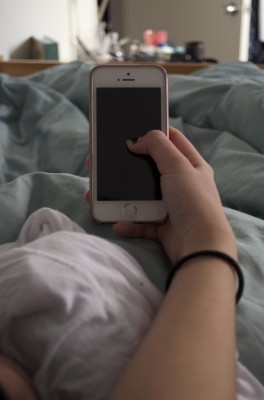Don’t Underestimate the Power of Airplane Mode

PAULA MADERO/THE OBSERVER
With the advent of smart phone technology, it’s become harder and harder to step away from our digital lives.
October 16, 2019
It was the notification from Chick-fil-A that drove me over the edge.
After a particularly long day of classes, followed by work and then more classes, I couldn’t wait to get home. All I wanted was to watch the Yankees, do some homework and go to bed. Exhausted was not the word — that would be far too weak to describe my level of fatigue.
Then, suddenly, disaster struck.
I was listening to music on my walk to Port Authority to catch a bus home when my enjoyment was interrupted by an unbearably shrill sound: a notification from Chick-fil-A. I had just passed one of their stores, which prompted the app to try to persuade me to stop in for some nuggets and lemonade.
That notification drove me over the edge of downright insanity. The horrible noise in my earbuds (and the wrist vibration from my Apple Watch that accompanied it) was the last thing I needed on that interminable day. All I wanted to do was shut my phone off. But curiously, I found myself emotionally unable to do this; I just couldn’t bring myself to swipe that red “slide to power off” bar. Why?
According to the “Screen Time” section in my phone’s Settings app, I receive north of 500 notifications per day. This includes texts, tweets, emails, Snapchats, news updates, Slacks, YouTube uploads, Lyft advertising, baseball scores … the list goes on. And although I love my Apple Watch, the constant vibrating is annoying beyond words and, to be honest, incredibly stress-inducing. I put up with it as much as I can, but at times, it becomes overwhelming.
The Great Chick-fil-A Incident of October 2019 was far from the first time I’d been genuinely bothered by a bombardment of notifications, or even just one. I complained to my friends this time, though, and they proposed a handful of possible solutions and easy fixes.
One person told me I should just turn my phone off. I told them that I couldn’t because I couldn’t miss a call from my boss or any of my superiors … or worse, my mom.
Another suggested I turn my phone on “Do Not Disturb” mode. I said no, because I couldn’t miss a text or email from any of those people, either.
I also heard that I should reconsider my notification preferences. For instance, maybe I don’t need all those Twitter updates from complete strangers. Maybe I can just check YouTube later. But what if one of those ringing pop-ups from hell tells me something I need to know ASAP? Even worse, how could I conceivably risk missing the update altogether?
Therein lies the problem: I just couldn’t let go of the notifications. I realized that I have a compulsion — not just a desire, but a perceived necessity — to know everything about everything all the time with up-to-the-minute updates and developments.
I tried to justify this by telling myself and everyone else that my need to be constantly plugged in was a good thing: It’s ambitious of me. it shows my drive. It’s proof of my dedication to learning about current events, doing well in school and working hard at my job.
But I had to ask myself: At what cost?
My mental health has taken a toll since all these notifications started to pick up. I’m stressed more greatly and more often. The stress turns to anxiety, which translates to worsened focus and, further, decreased performance in school and at work. It also makes me cling to the free time and social life I do have, which in turn gives me an increased ability to shirk my responsibilities. It’s a vicious cycle — and I mean vicious.
The saddest part is that I know I’m not the only one. So many corporations have marketing teams entirely focused on getting their content out to as many users as possible by any means necessary. These companies are fighting for our attention, and the resulting anxiety is practically endemic.
But I can only help myself, and for me, I intend to stop this vicious cycle in its tracks. While I am committed to being learned and hardworking, my mental health cannot fall by the wayside. There’s a balance somewhere in the middle, and for me, I think that solution is using the “Airplane Mode” and “Do Not Disturb” functions a little more liberally.
Lately, at work, I’ve started to restrict my phone to “Do Not Disturb” and set alarms to check for texts and emails every 15-20 minutes or so. When I’m commuting or listening to music, I’ve been switching on “Airplane Mode” to ensure I get all the “me time” I need. And whenever I’m with friends or family, I’ve been leaving my phone in my pocket or at home so I can devote my undivided attention to the people in my life whom I love and who deserve it — something I should be doing anyway.
My “plug-in rate,” the percentage of my time that I spend actively involved in my phone and checking my notifications, is fluid, and I’m working on finding my point of equilibrium.
This is an ongoing project for me, and I don’t think I’ve found my exact solution just yet. It might even change as my life does: I’m graduating soon, and I’ll be working full-time shortly after. Everyone’s story and life is different, so your individual plug-in rate might be different from mine. But ultimately, we should all focus more on finding our points of equilibrium than we currently do.










